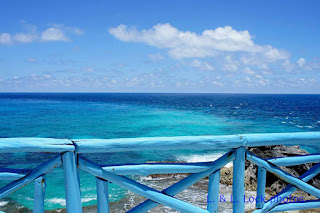 |
| Knock-your-socks-off turquoise! |
It’s a knock-your-socks-off turquoise. An eye-popping azure. A multitude of shades and hues.
The first time you see the Caribbean Sea, it
usually causes a stunned, jaw-dropping reaction. ‘Oh, my god, that’s beautiful.’
 |
| Youngsters enjoying the beach near our casa |
So, why is the Caribbean Sea so blue? We’re not trained scientists, just observers, and we read a lot, and this is our version of the reason.
The colour of water is controlled by a combination
of factors – depth, the floor of the sea, suspended particles (soil and
pollution) and plankton. Plankton are those tasty little organisms that
are the base of the food chain for the big, hungry ocean creatures.
 |
| 1987 north of Puerto Vallarta |
Depth – well, generally the deeper the water, the
darker the colour due to less reflected light.
However, in our opinion, the deep water of the Caribbean is a brighter sapphire
blue when compared to the light jade green of the Gulf of Mexico in the north, or
the deep cobalt blue of the Pacific Ocean on the west coast of Mexico. So what else is going on here?
 |
| Sand made of coral and seashells reflects the light |
Well, another big influence for determining water
colour is what is on the floor of the ocean. Pale pink or bright white sand made from coral bits and degraded sea
shells – mixed in with a few bits of lost pirate treasure - reflects light better
than the fine, darker sand found in the cooler waters to the north.
Then, as we mentioned, the amount of plankton and
other particles suspended in the water contributes to the colour. Phytoplankton, for example, harbours chlorophyll that absorbs red and blue light and reflects green. The more plankton, the greener the water. The Gulf of Mexico also has a high concentration
of river silt and fertiliser nutrients, added daily by the rivers draining into
the Mississippi River basin. All those
bits contribute to the pale green colour.
 |
| Isla Holbox in the Gulf of Mexico |
 |
| View of the Caribbean Sea from Isla 33 condos |
Whatever the reason, the
Caribbean Sea is just outright gorgeous. The clarity of the water makes it a diving and
snorkelling paradise.
Or if you prefer a
more sedentary form of exercise, hanging out by the water’s edge is a totally
relaxing way to spend the day. Staring
at the colour, listening to the gentle ‘shush’ of the waves, or immersing in
the warm salt liquid.
Heaven on earth.
Lynda, Lawrie, Sparky, and Thomas the Cat
 |
| Hanging out in paradise |
Or




No comments:
Post a Comment